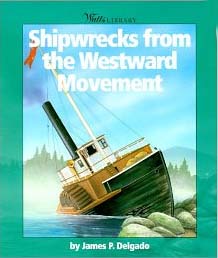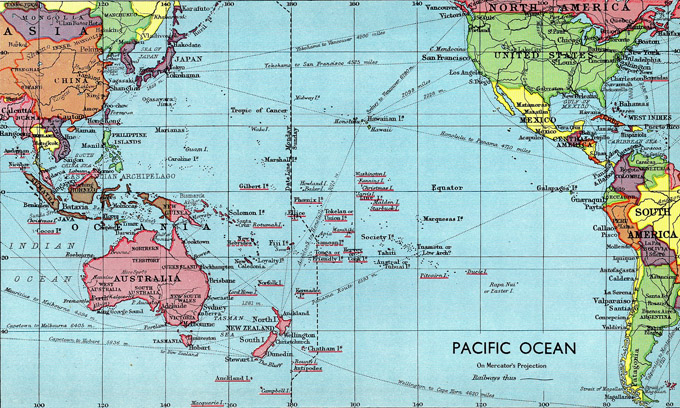Shipwrecks in Pacific Waters: 1800s

California's Dangerous Pacific Ocean
° Passenger Ship Arrivals
 Because there are hundreds of books and websites with stories of shipwrecks, this section will not grow extensively.
Because there are hundreds of books and websites with stories of shipwrecks, this section will not grow extensively.
A few well-publicized stories of San Francisco-based steamships that were total losses include:
- SS Brother Jonathan, wrecked off the North Coast of California, costing many lives, and subject to ongoing controversy.
- SS Independence crashed on a reef. A impassioned narrative from a passenger quotes Captain Sampson as saying that he dismissed the rocks as "whales."
- SS Tennessee lost inside of San Francisco Bay. Tennessee Cove was named in her honor.
SHIPWRECKS: 1850-1898 (Partial List)
- Belle, February 5, 1856, Sacramento River, California
- Bostonian, October 1, 1850, Umpqua Bar, Oregon
- Captain Lincoln , January 2, 1852, (Date is January 3, 1852 per H. Ex. Doc 1, 32nd Cong., 2nd Sess., Serial 674, 109)
- Carrier Pigeon, June 6, 1853, near Pigeon Pt., California
- SS North America, which sank off the Coast of Mexico February, 1852. This loss was the inspiration for The Maritime Heritage Project, because Captain James H. Blethen, great great grandfather of the Project's Founder sank the North America.
- Comanche, January 3, 1853, Suisun Bay, California
- Arctic, November 1854
- Contra Costa, April 3, 1859, San Francisco Bay, California
- El Dorado, 1853, Pt. Reyes, Marin County, California
- Exact, March 21, 1859, Crescent Bay, California
- Flagstaff, Spring, 1850, Rogue, River, Oregon
- Forest Monarch, 1859, off the Northern California Coast
- Georgiana, November 23, 1855, near San Francisco, California
- Helen Hensley, January 19, 1854, San Francisco Bay, California
- Lawrence, 1851, Off Golden Gate, California
- SS Lewis, April 9, 1853, Duxbury Reef, Marin County, California
- SS San Francisco, December 25, 1853
- Loo Choo, July 15, 1855, Umpqua River Bar, Oregon
- Lucas, November 1858, Farallones Islands (off of Golden Gate), California
- Mariposa, October 1850, San Joaquin River, California
- Major Tompkins, January 23, 1851, Sacramento River, California
- Mary F. Slade, September 6, 1859, near Cape Mendocino, California
- SS Newbern, 1893, Point Firmin
- Orbit, March 1850, Sand Island, Oregon
- Oregon, 1858, Pt. Reyes, Marin County, California
- Oxford, January 1852, Tomales Bay, Marin County, California
- R.K. Page, March 23, 1853, Sacramento, California
- Pearl, January 27, 1855, American River, California (This is interesting in that the American River is not a year-round deep-water river, with, perhaps the exception of the lower section near Sacramento. In early Spring, from snow melt and runoff, the river runs fast and dangerous, and floods when the volume is high. She is now damned and used extensively by river runners on the South and Middle Forks.)
Plumas, 1854, Sacramento River, California
- Robert Bruce, December 16, 1851, Willapa Bay, Washington
- Sagamore, October 29, 1850, Sacramento River, California
- Samoset, December 1, 1852, Fort Point, San Francisco, California
- San Francisco, Clipper Ship, Near Point Bonita, February 8, 1854
- Santa Clara, 1851, San Joaquin River, California
- Sea Gull, January 26, 1852, Humboldt Bar, California
- Sea Witch, 1855, Arch Rock, Golden Gate, California
- Tennessee, March 6, 1853, near Pt. Bonita, California
- Una, December 26, 1851, near Cape Flattery, Washington
- SS Yankee Blade struck a rock at Point Pedernales, California, 3:30 p.m., October 1, 1854
- Underwriter, 1857, Sacramento River, California
- SS Golden Gate, July 27, 1862 (Passengers List)
- SS Pacific, wrecked 1875 with 230 aboard, most of whom were lost when she rammed the square-rigged ship Orpheus north-bound for Puget Sound.
- Clara Nevada, 1898, Lynn Canal, near Seyward City, Alaska
- SS City of Rio de Janeiro, February 22, 1901
- SS Ohio, 1909, Wrecked in British Columbia waters

The eighty years spanning the California gold rush to the start of the Great Depression saw thousands of passengers and crews perish in Pacific steamship wrecks.

Great Shipwrecks of the Pacific Coast
Author Robert Belyk examines ten significant maritime disasters that occurred during one of the most turbulent eras in the history of travel. Real-life drama endured by those caught in the terrifying midst of disaster at sea and the causes behind the tragedies. Well researched, the shipwrecks accounted for here include:
- 1854: the Yankee Blade runs aground. Twenty-eight passengers lose their lives.
- In 1865, only 19 of the 204 passengers and crew on board survived the wreck of the Brother Jonathan, whose owners had been more concerned with maximum profitability than with the safety of their passengers.
- 1875: The old side-wheeler Pacific rams another passenger ship off the coast of Cape Flattery, Washington. Two hundred and seventy-seven people perish when her rotting hull gives way.
- 1906: The Valencia strikes a reef off the Washington coastline. Before dozens of dazed onlookers on the shore, the ship goes down taking 117 passengers and crew with her.
- 1907: The Columbia disappeared under the ocean surface in just eight minutes after ramming another passenger ship. Her poorly maintained iron hull simply gave out, leading to the deaths of 87 passengers.

April 9, 1851, Daily Alta California, San Francisco
On the 7th of January, 1851, the Brig Brutus, from the Republic of Chile, was wrecked on the coast, situated between the Salinas and the port of San Quentin, or rather between the Rancho of San Ramon and the Salinas, on the frontier of Lower California, in which accident, the captain, the second mate, and four seamen were drowned, (as resulted from investigations made), and the only persons who escaped were the first mate and a cabin boy.
The crew list and other documents belonging to this vessel were lost, but three thousand bags of flour, of one hundred pounds each, part of the rigging and sails, and some old furniture, were saved from the wreck, and are now in deposit.
The undersigned, the constitutional alcalde of the before mentioned frontier, being desirous that these circumstances should become known to the parties who have, or consider themselves to have a claim to the remnants of the vessel and its cargo, now makes them public, through the medium of the present notice, in order that such parties may present themselves within the tern prescribed by law to justify their claims. And at the same time he announces, that having consulted the despatch communicated on this subject to the District Judge, resident in the port of Milego, he shall proceed when said District Judge ordains, to offer for sale the property saved, for the best interests of the owners of, or of those who have a claim to said property, as the cargo is in an isolated locality, remote from any town, and being already damaged, it might result in a total loss if not promptly disposed of.
Signed, TOMAS, BONALL, Countersigned, DOLORES LUCERO, Secretary.
Santo Tomas, March 17, 1851
The original document, of which the above is a translation, can be seen at the office of
Wm. H. Davis.
August 5, 1851, Daily Alta California, San Francisco, California
Shipping Intelligence
MEMORANDA
DISASTERS ON THE CHINA SEA.--
We are indebted to Captain Moore, of the barque Adelaide, for the following information:-- H.B.M. steam sloop Reynard and the brig Arab sailed from Hongkong on the 2d of June, for Pratte's Shoal, for the purpose of rescuing the crew of a British brig that had been cast away there some time previous. The Shoal is in shape of a horseshoe. On the 6th of June, being near the north point of the Shoal, a commotion was discovered in the water ahead, which was thought to be a tide rip, but proved to be the Shoal, as the vessel struck shortly after. She struck hard and fast, forward, while under her stern there was 20 feet of water. The sea becoming rough shortly after, broke her in pieces. The Arab, being close to at the time, came to the assistance of the steamer and saved all persons on board. Immediately after, the brig they were in search of was discovered on the south point of the Shoal, and the Arabsucceeded in rescuing her crew also, and brought them all safe to Hongkong.
The American clipper brig Eagle sailed from Calcutta for Hongkong about the middle of Nov., 1850, and has not been heard of since. She is supposed to have foundered during a typhoon in the Bay of Bengal.
The British barque Larpent, that had been missing for sometime, has been heard from through three of the crew, who were picked up at sea, off Cape Formosa, by the Am. brigAntelope. The Larpent struck in the night on Cape Formosa, backed off again, filled and went down -- leaving those on board barely time to clear away the boats. Six of the sailors took the jolly-boat, which was capsized in the surf while attempting to reach the shore. One of them was drowned, being unable to swim -- five succeeded in reaching the beach, when they were attacked by the natives, and two of the number cruelly murdered. The surviving three were sold as slaves. The remainder of the crew, including the captain and mates, started in the long-boat for Hongkong, and are supposed to have foundered, as they have not since been heard of.
A vessel-of-war has been dispatched to the scene of the wreck, to punish the natives for their cruelty.
Beyond the Golden Gate: A Maritime History of California
Timothy G. Lynch
Maritime historian Timothy Lynch looks at the history of the Golden State through the prism of the maritime world: how the region developed and how indigenous people interacted with the marine ecosystem. And how they and others - Spanish, English, Russian, American - interpreted and constructed the oceans, lakes and river networks of the region.
Waterways served as highways, protective barriers, invasion routes, cultural inspiration, zones of recreation, sources of sustenance: much as they do today. He presents how the Gold Rush transformed the region, wreaking havoc on the marine environment, and how the scale and scope of maritime operations waxed and waned in the decades after that event. In all, the delicate balance between protection and utilization is paramount.
Written as part of a project with the National Park Service and the Organization of American Historians. Benefitting from hundreds of primary sources, dozens of captivating images and reflective of the latest trends in the field.




 Copyright ~ 1998-2018.
Copyright ~ 1998-2018. 